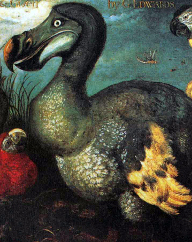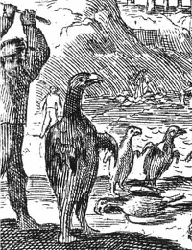
For the 80 years we knew them, dodos had a pretty crap time. Between 1598 and 1681 we drove them into extinction. After that we had so little evidence they’d ever even existed that people began to think the bird was mythical. It wasn’t until the 19th century that people began to realize we had enough funky bones loitering around museums to prove there really was a dodo. Even now we don’t quite know what they looked like. Dodos were often drawn from descriptions or copied from existing sketches. It’s been said that the notion of a comically fat, awkward bird is actually based on a picture of a grotesquely overfattened animal in captivity. However, I will leave such petty flimflam to the naturalists. I’m concerned with something far simpler: what did they taste like?
It’s no great revelation that people ate dodos. On one hand we’ve got hundreds of sailors looking for an easy meal and on the other a bird that can’t get away. Dodos were the 17th century equivalent of vending machines. And this is where original accounts of the dodo come in handy, because those diarists knew perfectly well that what wine you serve with dodo is just as important as their taxonomy. Here we go, the earliest description of a dodo from the expedition in 1598:
We called them Walckvögel [“disgusting birds”], for this reason, that the longer they were boiled, the tougher and more uneatable they became. Their stomachs, however, and breasts were well tasted and easy to masticate. Another reason for the name was that we had an abundance of Turtle-doves, of a much sweeter and more agreeable flavour.1
Another account from the same year corroborates the taste of the bird: “We cooked this bird, which was so tough that we could not boil it sufficiently, but eat it half raw.”2 An account from 1606 tells us you could salt dodo meat and presumably provision a ship with it: “All the while they were here, they lived on Tortoises, Dodos, Pigeons, Turtle-doves, grey Parrots and other game, which they caught by hand in the woods. The flesh of the Land Tortoises was very well tasted. They salted and smoked it, and found it very serviceable, as were the Dodos which they salted.”3
One particular gentleman, Sir Thomas Herbert, is a little more decisive than his precedessors: “greasie stomackes may seeke after them, but to the delicate, they are offensiue and of no nourishment”. The same author wrote later, “meat it is with some, but better to the eye than stomach; such as only a strong appetite can vanquish: but otherwise, through its oyliness it cannot chuse but quickly cloy and nauseate the stomach, being indeed more pleasurable to look than feed upon.”4

So what we have here is a tough, fatty bird with greasy meat, but offering a decent meal to anyone with a “greasie stomacke”. The stomach and breast were the best parts, and were apparently quite agreeable. The bird could be cooked by boiling or preserved by salting. Let me jump in and curtail an obvious joke: THEY DID NOT TASTE LIKE CHICKEN. To me it sounds more like a tough, nasty version of duck. A red wine might suit dodo meat, or perhaps a white if you’re eating it salted? Alas we’ll never get to find out for ourselves, but I will leave you with one thought: Pickwick, the dodo in the Thursday Next series of books, was cloned and sold as a household pet. Could cloning be the answer to our question about how to serve a dodo? And what other delicious dead things could we serve up at the same time? Tasmanian Tigers? Stegosauruses? Neanderthals?! The field of palaeo-gastronomy is in its infancy, but I feel like it has the potential to boom in the coming century.
Notes
-
Strickland and Melville, 123. The Latin account of the voyage they translate from says “plus lentescerent” — “softer”, not “tougher” — although I’m not sure where the disparity was introduced. Rothschild, 172, presumably translating the original Dutch, also says tougher. ↩
-
Strickland and Melville, 124. ↩
-
Strickland and Melville, 125. ↩
-
Strickland and Melville, 20. ↩
Bibliography
-
Rothschild, Walter. Extinct Birds. London: Hutchinson & Co., 1907. Print.
-
Strickland, H.E. and Melville, A.G. The Dodo and Its Kindred. London: Reeve, Benham, and Reeve, 1848. Print.